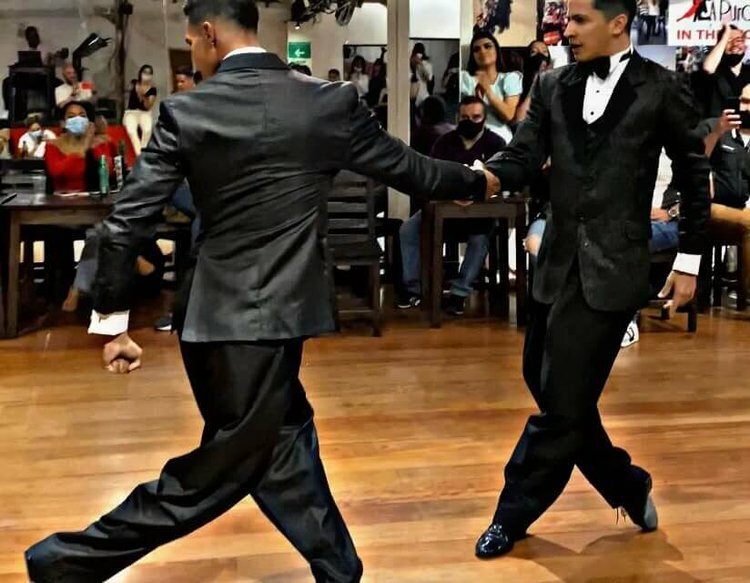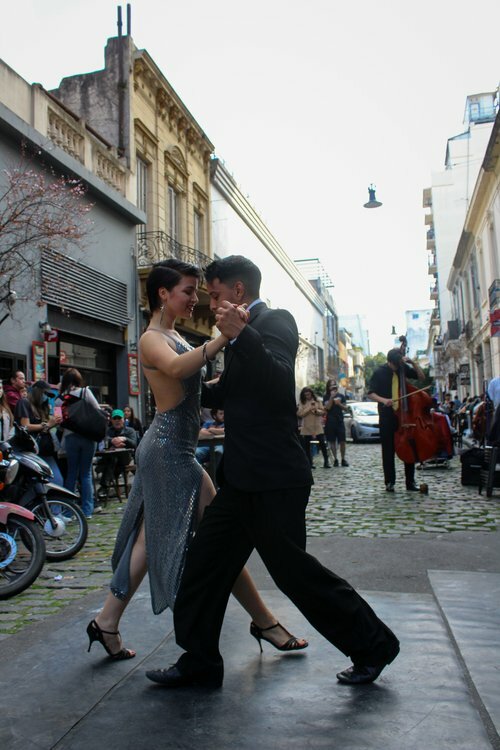When you watch a couple dancing the tango, it’s impossible to miss the passion, intensity, and masculine energy that oozes from every pore.
There’s something about the way the man moves with such purpose and authority, while the woman seems to melt into his arms after she follows his lead.
It’s no wonder that tango is often referred to by many as the most masculine dance that exists.
There are a lot of aspects the world can discuss about tango. We can start with its artistic history, move on to the birth of different styles, and then master the códigos that make the milongas an integral part of the tango experience. However, today we’re going to focus on the gender of this dance and music.
Is tango really a masculine dance? If so, what makes tango so masculine?

A Different Look at the Tango History
Learning about tango always takes us back to its roots. We all know it;
tango is a product of cultural mixing. It emerged in the lower-class neighborhoods of Buenos Aires and Montevideo at the end of the 19th century.
At that time, the porteños (residents of Buenos Aires) and criollos (Uruguayans of European descent) were living near each other and sharing their cultures.
The music, the way of life, and even the way of walking all blended together.
Tango was born out of this cultural melting pot, and it was danced in the streets, at parties, and in brothels.
It was a dance for the people, by the people.
But did you know that the dance began informally even before the first published tangos? What does that mean?
According to Quartz, the first published tangos date to the 1870s.
This suggests that the tango informally started the previous decade when the Argentinean society was predominantly male. Tango teacher Daniel Trenner shared that there were much more young men than women before, and a social dance was one of the few places to possibly meet a woman. Moreover, anthropology professor Julie Taylor said there’s no evidence suggesting the tango began in brothels then.

Men would practice together, perfecting their polka and waltz so that they could impress a woman when the time came. It seems the tango began in the tenements as the men’s fantasy dance.
Every record of tango history also discusses the time when it was considered a scandalous dance.
Eventually, tango became the Argentinean culture’s badge of honor. It was a dance that showed the world that they were different, passionate, and intense.
It wouldn’t have been possible to make the culture live on if the tradition of men learning the dance together stopped.
Taylor says that older generations have told her about “nurturing” the dance. The tango belonged in the home, she says, in part because in the early 20th century the streets were dark at night and nightlife was considered indecent.
Fathers considered it their cultural duty to pass on the tradition of the tango.
“They understood this was an Argentine dance,” she adds.
While modern tango considers a man and a woman the perfect couple for the dance, Trennor and Taylor point out how it is really far from the gaucho tradition. Moreover, a good tango dancer must know how to lead and follow.
Learning the steps is not enough; you must have a good sense of connection and communication with your partner on the dance floor.
How does this different look at tango history make tango masculine?
Though the suggestion connects tango more to LQBTQ+ culture, the fact that men used to dance more than women lends more credence to the masculine aspects of the dance.
Men had to master the steps and the movements more to lead their partners. Tango involved more men because they were the ones who had to perfect the dance in order to woo the ladies.
Modern Tango Gender Roles
As mentioned earlier,
modern tango is typically associated with a man and woman as the perfect dance couple. The man leads, and the woman follows — that is a general idea.
Moving away from the gaucho tradition, modern tango needs two partners to play different roles, corresponding to masculine and feminine energy.
In Search of Tango says that men assume the masculine role in tango as they do in life.
Frankly, a woman is too soft, light, and fragile to be the leader. She simply cannot be as strong and reliable as the leader must be and function as a man must function to a woman regardless of how technically knowledgeable she is on leading. Likewise, a man is too heavy and robust to be the follower. He simply cannot be as flexible and light as the follower must be and function as a woman must function to a man regardless of how technically knowledgeable he is on following.
The man in tango has a lot of functions. He plots the dance, leads and supports the woman, and most importantly, shines and protects her.
Leading the Follower
The man must know how to lead the woman in tango movements.
This is not always easy since the woman must be able to follow his lead. A good leader makes it look easy for the woman to follow his steps and move gracefully around the dance floor.
Plotting the Dance
If the woman dances around the man, the man dances around the dancefloor. According to In Search of Tango,
learning the tango for women is not about learning steps but learning to be one with the man. It is the man who plots the dance, who decides the direction, and who chooses the steps.
The woman must be able to let go and trust her partner.
Supporting the Follower
The woman knows how to carry herself when dancing the tango. She is light on her feet, and her movements are fluid. However, the man must still know how to support her weight and guide her around the dance floor.
Balance and coordination are important for both partners.
Dancing to the Music
As a leader, a real man in tango must know how to dance to the music.
He must be in tune with the rhythm and the melody, so he can lead his partner accordingly. The woman must also know how to dance to the music, but she ultimately follows her partner’s lead.
The man is the one who sets the pace.

Shining the Woman
The man you dream of in tango must be able to make the woman shine.
He does this by leading her gracefully around the dance floor and making her feel special. The woman must also know how to shine on her own, but the man plays a significant role in how she moves on the dance floor.
It’s the man who allows her to fully reveal her feminine beauty.
Protecting and Pampering the Follower
The man in tango must be able to protect the woman while they are dancing.
This means being aware of other couples on the dance floor and making sure that their partner is safe.
Moreover, a man dancing the tango must be able to pamper his partner and make her feel comfortable.
He should be about gentleness, patience, and protection. The feminine role in tango is about being graceful, passionate, and sensual.
The masculine role in tango is about being strong, leading, and protective.
Both roles are equally important in order to create a beautiful and harmonious dance, but it’s undeniable that the masculine role is, at some point, more dominant.
Tango Texts
Apart from tango as a dance, it’s also interesting to look at the lyrics of tango music.
Eduardo P. Archetti looks at the tango through its social and historical setting and the Argentinian literature and the interpretation of the meaning of the tango lyrics. Masculinities: Football, Polo and the Tango in Argentina
explores the masculinities and morality in the poetics of the Argentinian tango, revealing how the music has been used to express and negotiate masculine values and identities.
The tango is a dance that has been around for centuries, and it’s vital to learn about the music as well.
The lyrics of the tango can be seen as a reflection of different types of love: love as duty, love as passion, love as a deep friendship and, finally, romantic love.
Archetti shares several tango lyrics, such as “Mi noche triste” by Pascual Contursi in 1917 and “Farolito de papel” by Garcia Jimenez. The lyrics allow us to discover that tango often sings about the woman leaving the man to go off with another man.
Archetti says that tango illustrates how a woman’s behavior is labeled as morally good or bad based on the people (specifically men) around her.
However, tango can also be about human suffering and unhappiness, regardless of whether they’re men or women.
Tango expresses that happiness is only possible if a man or a woman’s behavior is guided by sincere and authentic love.
So if tango mostly expresses a man’s heartbreak after a woman leaves him, what does it make of the tango?
The tangos, perhaps more than anything, defend a male morality by romanticizing a kind of subtle emotional control over women.
Another interesting take on tango lyrics is Maria Luisa Carnelli’s Se va la vida (1929). It’s interesting because Carnelli is the only woman who reached some status as a composer, but she wrote all her tangos with a male pseudonym — Mario Castro or Luis Mario. Her advice was to let go of suffering and virtue. Her tango talked about forgetting the values imposed by men and social circumstances and pursuing happiness — which meant a good life offered by a rich man.
It’s interesting because Carnelli is the only woman who reached some status as a composer, but she wrote all her tangos with a male pseudonym — Mario Castro or Luis Mario.
Her advice was to let go of suffering and virtue.
Her tango talked about forgetting the values imposed by men and social circumstances and pursuing happiness — which meant a good life offered by a rich man.
The lyrics suggest that tango is all about a man’s emotions and feelings after a woman’s decisions. A man could be a reason for a woman’s happiness or unhappiness.
If a woman is unhappy, the next step to happiness is still a man. It all seems to return to a man’s role in tango-control, power, and leading.
Dancing to the Masculine Tango
At this age and time, defining a dance as masculine or feminine is rather difficult (and unnecessary).
However, we can still see that some dances are more masculine than others. The tango definitely falls into this category.
Though the feminine role has become more dominant in recent years, and dancers are seeing the crucial importance of both roles, the masculine role is still very much alive in tango.
Many tango teachers don’t teach gender roles in their classes, but in Argentina, tango undeniably works according to the man’s masculinity and women’s femininity.
Argentine tango is a passionate and elaborate display of the two. It inevitably highlights the masculine role through power and control. Archetti added:
In the words of Manucho:
“the tango reflects a doubting masculinity, not machismo, and powerful women like we have plenty of in Argentina. You must remember that the romantic tangos have survived and will enter the next century, not the others; and saying this I will not deny that there is machismo in Argentina, but the world of compadritos has disappeared.”
To many tango dancers, tango can be the most masculine dance to ever exist. It can be seen as a dance that revolves around a man’s power, control, and dominance. After all, it’s impossible not to notice a leader’s masculine role when he’s guiding his partner around the dance floor with such confidence and ease.
Though many may see tango as a masculine display of power and dominance, others see it as the most sensual and intimate dance in existence.
It’s a dance that can be shared by two people who are completely in sync with each other — mentally, emotionally, and physically.
Tango is a balance between masculine and feminine energies. It’s a give and take between leaders and followers.
Regardless of its historical context or the lyrics of its music, there’s no denying that the masculine role is an integral part of Argentine tango. Tango the dance would not be the same without it.
It doesn’t matter if you are entirely new to dancing… or have been dancing your whole life. We distill everything you need to know to be able to hit the milonga into simple, easy-to-understand steps. Regardless of your level, this course has something for everyone!
At the end of Tango Passport, you’ll be able to improvise and dance the tango…. anywhere in the world. More details HERE.

